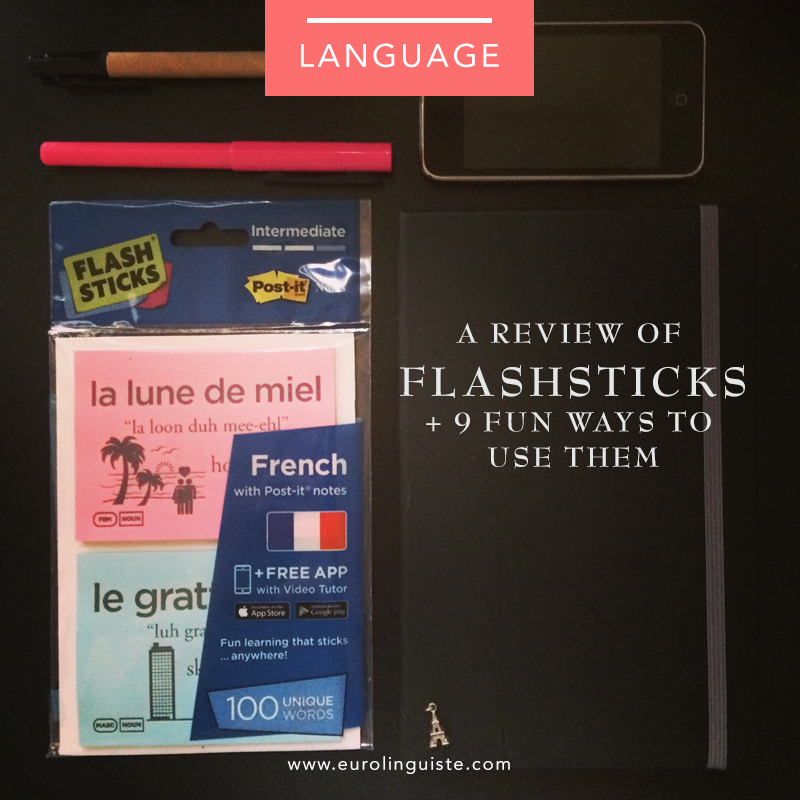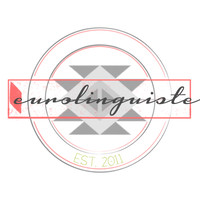A Review of Flashsticks + 9 Fun Ways to Use Them

My name is Shannon Kennedy and I'm the language lover,…
Since writing this article, Flashsticks were discontinued.
If there weren’t already existing flashcard decks on applications such as Memrise and Anki, I probably wouldn’t bother to study with flashcards which is a shame because flashcards can be a great way to retain and refresh vocabulary in a new language. I still have blank notecards left over from high school, but I’ve never gotten around to sitting down and writing useful vocabulary on them! It isn’t that I don’t like studying with flashcards, it’s more that I don’t have the time to sit down and create them. But then I discovered Flashsticks through Instagram.
About Flashsticks
Flashsticks are sticky note flashcards that include vocabulary in your target language, the translation, pronunciations, images other cues to help you make the most of your vocabulary study. Flashsticks uses Post-It notes to print their flashcards so you know you’re getting a good quality and long-lasting product. I placed my notes on a variety of surfaces and they stayed right where I put them until I was ready to take them down. The only surface I really had any issue with was one that was a bit dusty. The flashcards are broken up into three different levels; beginner, intermediate and advanced. There are 100 to 200 unique words in each pack including nouns, verbs, adjectives, and adverbs. The box sets have 600 words. The purchase of Flashcards gives you access to their app, which provides you with the pronunciation of the words by native speakers. You simply have to hover your phone or smart device over one of the cards to get started. They are currently available in French, Spanish, Italian, German, Mandarin, Portuguese, English, and British Sign Language.
My Thoughts
Flashsticks is right when they say that their product is a fun way to learn a language. I can definitely see this as an extremely effective way to work with children. I mean, what kid doesn’t love playing with stickers? Especially when they get to stick them wherever they want! Although the set I received is geared for an English speaker to learn French, I definitely plan to use them to help Mini M learn English. I love that the words are color-coded. For languages like German, French, Italian and Spanish, learning the genders or words can be a real struggle. The blue/pink/green colors for each of the words is a really great way to subtly and effectively remind you that la lune is feminine and le gratte du ciel is masculine. There are as many as 600 something words per language available through Flashsticks (the box set as 600 which each individual pack as 100). Each set is geared towards a specific level and the words selected for each set are creative. There are definitely words in each pack you might not think of if you’re creating your own flashcards.
Things They Can Do Better
Flashsticks uses a simplified phonetic system to help you properly pronounce the words, and I think that’s great since it allows anyone to pick them up and get a general idea as to the pronunciation of the words. The written pronunciations I feel, however, are somewhat inaccurate. They do guide you in the general direction as to how the words are to be pronounced, but I felt as though that area can definitely be improved. On the other hand, they do have the free app that provides a way to hear the words pronounced by native speakers, so that will hopefully resolve any doubts in regards to pronunciation.
Conclusion
I really like Flashsticks. I think that they are a fantastic idea. Flashcards are an inevitable part of language learning and Flashsticks simplifies that aspect by creating and color-coding the vocabulary lists for you. The fact that you can stick them anywhere makes them a really great way to both passively AND actively work on your target language anywhere and everywhere.
9 Ways to Get Inventive with Your Flashsticks
- Use them as bookmarks. That way you’re reminded of a word you’re struggling with every time you open your book.
- Stick them on random pages in your language notebook so that you’ll be surprised with a new word after X pages of notes and review.
- Put them inside the door of your medicine cabinet or on your bathroom mirror so you can study while brushing your teeth or combing your hair.
- Bring them to your office or to school and stick them on your desk so that you can study both at and away from home.
- Once the adhesive runs out, fold them and stick them in a hat or bowl. Shake it up and randomly select words at odd intervals to get just a little more life out of them!
- Put a new word on your phone so that you have to look at it before you check your email or Facebook the next morning.
- Try to put the words given to you into sentences each time you see them. A new sentence each time!
- Stick one to the front of your shirt so you see it every time you look in the mirror. Attach or fold them around every bill or card in your wallet so you get some review in each time you go to pay.
- Stick them inside the cases of movies or CDs you open up regularly (or that you plan on opening in the near future) so that you get surprised with new words.
What is your favorite way to study new vocabulary? Have you tried Flashsticks? I’d love to hear your thoughts in the comments below! Full disclosure: I was given a set of Flashsticks in exchange for writing this review.
My name is Shannon Kennedy and I'm the language lover, traveler, and foodie behind Eurolinguiste. I'm also the Head Coach of the Fluent in 3 Months Bootcamp, co-founder of Women in Language, and former Resident Polyglot at Drops.



